The Cyclades, or, Life Among the Insular Greeks
“Mr. Bent has done admirably, and gives most picturesque sketches of the weird, the waste, the wonderful, as well as the human and homely aspects of the Cyclades.”- The Athenæum, No. 3004, May 23, 1885, pp. 658-9.
First published by Longmans, Green & Co., London, in 1885, Bent’s classic, and rarely out of print, account of winter months in 1882/3 and 1883/4 spent exploring the Greek Cycladic islands, is still, rightly, considered the must-have accompaniment to any visit (including the virtual), no matter how well you think you know these beguiling places. A reprint of Bent’s classic work is available from Archaeopress, Oxford (2002).
Reviews of all hues soon began to appear in the summer of 1885 – as the Bents were already preparing for a trip to the Dodecanese – perhaps the tour de force being the following early one by an anonymous reviewer (bet on the mercurial Henry Fanshawe Tozer, iron-fisted and velvet-gloved) in The Athenæum, No. 3004, May 23, 1885, pp. 658-9.
There can be no excuses for not including it in full, with a few endnotes here and there:
The Cyclades. By J. Theodore Bent. (Longmans & Co.)
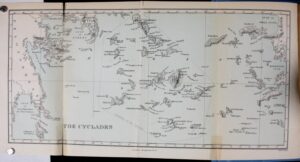
“In a small and modest form Mr. Bent has given us the results of rather arduous researches. His life in the Cyclades, in spite of all its interests, must have entailed upon him very great hardships, more especially as Mrs. Bent ventured to accompany him. The accommodation for travellers in the remoter parts of continental Greece is bad enough; it seems worse in the islands, and whatever a single man may endure, to see a lady exposed to such hardships must be trying indeed. note 1 But Mr. Bent has done his work bravely, and produced the first good sketch of the islands which has appeared for a very long time. His map and full descriptions give a life and meaning to what are mere names in history, and we now know how to differentiate Naxos, Paros, Keos, and Amorgos better than by their mere titles, or the names of the great men who chanced to be born there.
“Mr. Bent’s chief interest in travelling is in the direction of folk-lore. Having mastered colloquial Greek, which was of course indispensable, he was able to pick up many most interesting traces of old customs and superstitions. These are the principal feature of his book. They almost all point back to half-effaced paganism, over which the Greek Church has laid a varnish of names and external ceremonies. It would have been most useful if he had classified these customs in a good index; he has given them as he heard them in each island. He is necessarily reticent, too, in a book meant for general reading, and has evidently heard and seen many things of the greatest anthropological interest, which he should communicate to the society which collects that kind of human history.
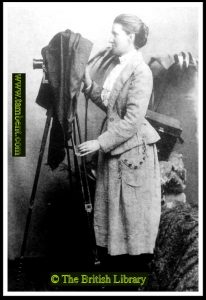

“The classical reader will, perhaps, regret that he did not bring with him what may be thought even more important; for the allusions to old Greek authors in his pages are so loose that we cannot but suspect them to have been obtained at second hand, and with little feeling for that accuracy which is the chief boast of Greek scholarship. When he talks (p. 201) of ‘Arato, an old writer’; of ‘Laertus’, x. 6 (p. 439, i.e. of Diog. Laertius); of Artemis as παιδότροφος, κουρότροφος (p. 457); of ‘εἴμαι, to go’ (p. 80), one wonders where he got his references, and how his modern Greek did not teach him the importance of accents. Many other similar things lead us to suspect him of doing what an independent worker in an almost new field has no excuse for doing – taking things up from books without acknowledgment. But if he has done so vengeance will surely overtake him, for not the highest scholarship or the most elaborate defences will save him from his critics. If, on the other hand, our impressions are unwarranted, we hereby offer him our hearty apologies, and only request him in his succeeding editions to quote in full the Greek texts he cites, and also any modern authorities which may have anticipated him. It seems, however, a sort of law that a classical scholar is not to be a worker in the field of antiquities, or even a competent judge of such matters, and so that all our researches must be made by men who have not attained that haven of rest. In the face of this unfortunate division, caused, no doubt, by the numbing effect of sixth forms and university honours, our sympathies are strongly with the workers, like Mr. Bent, who bring us new material for thought instead of improving the form of those who work the old classical treadmill. Yet he would, no doubt, have ‘spotted’ many more remains of old Greek life had he really been more intimate with Aristophanes than his references to that author imply. We also express an earnest hope that he will print the Greek text of the many songs and sayings which he has given us in English versions. In such allusions the ipsissima verba should have been reported, at least in footnotes. note 3
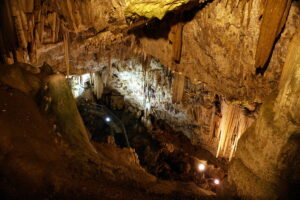
“We turn lastly to the third feature in this most interesting volume, which gives us information that all will appreciate. Travelling among the islands being very difficult and not to be done comfortably except in a yacht, it is of the last importance to have their physical features so described that the splendid and striking features can be included in a tour without spending time upon what is merely barren rock and treeless plain. This Mr. Bent has done admirably, and gives most picturesque sketches of the weird, the waste, the wonderful, as well as the human and homely aspects of the Cyclades. The volcanic features of Therasia, the cliffs of Pholygandros, the convent and coasts of Amorgos, and the stalactite grotto of Antiparos are the points which the inevitable Cook will one day make the chief attractions of his excursion steamer note 4 . The dimensions of the grotto are indeed astonishing. Our author gives them (p. 401) as 720 feet long, 670 wide, and 360 high, and says the whole ‘resembles a lovely cathedral sparkling with gems, the dome of which is supported by pillars of exquisite workmanship’.
“The character of the islanders corresponds to what we know of the Greek peasant who lives beyond the baneful influence of the Levantine ports. They are kindly, honest, and harmless, and though there was the usual random talk about pirates and brigands, Mr. and Mrs. Bent seem to have been as safe as in England. Two points strike the reader as curious. The first is the want of communication among the islands, which seem isolated in the most extraordinary manner. Some have no post for a fortnight, some for a month. The author was constantly delayed by inability to get a boat passing to the next island. The second is the curious want of humour, or rather the delight at only the tamest possible jokes, which indicates some strange decay in the Greek intellect. It is the most hopeless feature in the race. Can any nation now become great without being able to appreciate the ridiculous? note 5
“We had a word to say about Mr. Bent’s style, which is colloquial beyond the ordinary limits, but forbear to weaken in any way the favourable impression of the book which we hope to have conveyed to our readers.”
What other reviewers had to say:
Morning Post – Wednesday, 8 April, 1885: “These sketches of life and nature, and art in the Cyclades are unpretentious, but the subject is comparatively fresh and is admirably presented, making the book one of the most welcome of those that have recently appeared.”
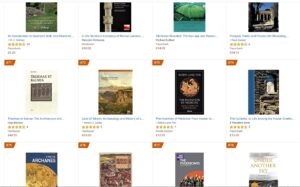
St James’s Gazette – Friday, 8 May, 1885: “Mr. Bent’s sketches of scenery are quiet and good. As to the treasures of folk-lore which his book contains, we can make no attempt in this notice to give the reader an inkling of them. It is a book that richly deserves to reach, and soon, a second edition; and when it does Mr. Bent will do well to have it corrected for the press by some one who understands the syntax of English pronouns. There is also a passage on the teaching of Greek at the University of Syra which needs correction. The Oxford don of to-day is not quite so easy a butt as Mr. Bent imagines; and where he less of a scholar than Mr. Bent believes, it is not for a writer who talks of Terence’s ‘Adriana’ to gird at him.”
Academy 27, Jan/June 1885, p. 322: “Mr. Bent’s book deserves all success, for it is the result of researches pursued in the most laudable manner. When an educated man selects for his field of observation an interesting and little-explored area of country, and, after learning the language, spends a considerable part of two winters there, living among all classes of people so as to familiarise himself with the details of their life, and to become intimately acquainted with their ideas and modes of thought, he deserves the title of an enthusiastic investigator.”
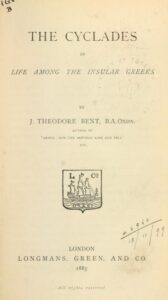
Notes and Queries, 6th Series, xi, April 11, 1885, pp. 299-300: “Within the limits of Europe it is not easy to find another race concerning which so little is known as the inhabitants of the islands of the Aegean Sea. Amongst these islanders Mr. Bent, accompanied by his wife, spent two winters [1882-3/1883-4], his chief objects being the study of Hellenic archaeology and the collection of folk-lore. In both respects his residence has proved remunerative, and scholarship is the richer for his exploration. He has written, indeed, a work of far more than temporary interest… In all substantial respects the work is worthy of high praise. It is difficult, indeed, to say whether it is more interesting when from the standpoint of yesterday or that of today, for the light it throws upon the customs of the early Greek or for the proof it affords how much superstition lingers in the heart of countries avowedly Christian… A rich harvest has rewarded Mr. Bent’s labours. The part of his work which will have most permanent interest is that in which he shows what traces of the influence of Greek faith survive and colour modern life… The Cyclades is, indeed, full of interest and suggestion. To the student of folk-lore few equally more important and stimulating contributions have been made during recent years.”
Several modern authors have travelled with Bent in their pockets
V.C. Scott O’Connor, Isles of the Aegean (1929, Hutchinson & Co. Ltd., London) (Incidentally, 1929 was the year of Mabel Bent’s death.)
John Freely, The Cyclades. Discovering the Greek Islands of the Aegean (2006, I. B. Tauris, London).
Lawrence Durrell, in his equally indispensable The Greek Islands (1978, Faber & Faber, London). The author is unfairly dismissive of the lesser isles, but an obvious admirer of Bent: “I do not think I shall be accused of taking my islands too lightly, if I now attempt to deal with a job lot of pretty, but very similar islands, which have considerably less to commend them in terms of monuments, though their charm is undeniable. Seriphos and Siphnos sound like the Heavenly Twins, and are very similar in size and scope. Kimolos and Sikinos are hard to visit, and harder to escape from, owing to their position off the beaten track; frankly it is not worth the trouble to do so, unless you are as determined and thorough about your Aegean as old Theodore Bent – who wrote the classic on the area.” (p. 254)
Ernle Bradford, doyen of craft-sailors, writes in The Companion Guide to the Greek Islands (1983, Collins, London, p. 156), of trying to land in adverse condition on Pholegandros: “James Theodore Bent came here and described it [Pholegandros]. I can do no better than recommend his book to other Aegean travellers, an impertinence perhaps to recommend Bent, but too few people nowadays seem to be acquainted with his work…. It is the classic of Aegean travel in English and will never be superseded, for one good reason that Bent was lucky enough to visit the islands when they were still, as it were, intact and only just waking out of the sleep of centuries. A Yorkshireman, Bent was one of those hardy and indefatigable Victorians who make the modern traveller feel somewhat ashamed. Accompanied by his wife, herself an expert photographer, Bent spent a long time in the Aegean, the fruit of which was The Cyclades; or, Life Among the Insular Greeks… If my inability to land on Pholegandros has done no more than introduce some new readers to Bent’s book, it has been worth while.”
And among modern archaeologist Bent-admirers writing in English on the area, one might cite Robin Barber, The Cyclades in the Bronze Age (London 1987), Cyprian Broodbank, An Island Archaeology of the Early Cyclades (Cambridge 2002), Ina Berg, The Cycladic and Aegean Islands in Prehistory (Abingdon 2019), etc., etc.

The version from Forgotten Books is a facsimile copy of the original book and contains over 500 pages. The copying has rendered the print to be quite light. There is no additional material in this edition. It is available in hard-back or paper-back versions.
 Aegean Islands (The Cyclades or Life Among the Insular Greeks) (A.N. Oikonomides (ed.), 1965, Argonaut, Inc.)
Aegean Islands (The Cyclades or Life Among the Insular Greeks) (A.N. Oikonomides (ed.), 1965, Argonaut, Inc.)
This hard-back version is a facsimile of the original book but with a lot of additional information, maps and pictures. It is no longer in print but single, used copies do appear on Amazon and elsewhere from time to time.
 Free online edition via archive.org.
Free online edition via archive.org.
Notes
Return from Note 1
Return from Note 2
Return from Note 3
Return from Note 4
Return from Note 5

